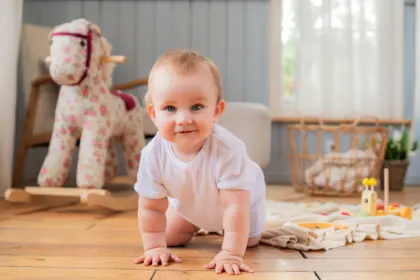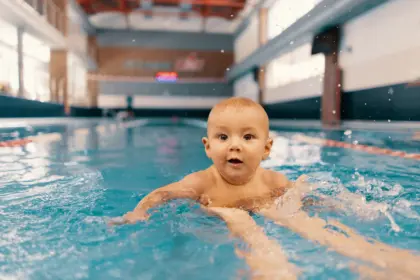0 - 3 Months
I can start to learn about the world around me.
- Talk and Sing: Engage your baby with talking and singing to expose them to language and sounds. This helps with early language development. Sing lullabies, nursery rhymes, and talk to them about your day. The rhythm and melody of your voice can be soothing and stimulating. Talk with me | GOV.WALES Nursery Rhymes Caneuon Cyw
- Visual Stimulation: Use high-contrast toys and images to stimulate their vision. Black and white patterns are particularly effective at this age. Hang a mobile with contrasting colours above their crib or play area to help develop their visual tracking skills. Visual Stimulation - Twinkl
- Tummy Time: Encourage tummy time to strengthen their muscles and promote motor skills development. Place your baby on their tummy for short periods while they are awake and supervised. This helps build neck, shoulder, and arm muscles. Top tips for tummy time | NCT
- Gentle Massage: Give your baby a gentle massage to help them relax and improve circulation. Use baby-safe oils and gently massage their arms, legs, and back. This can also enhance bonding and improve sleep patterns. What is baby massage? Top tips and benefits - BBC Tiny Happy People
- Reading Aloud: Start reading simple board books to your baby to introduce them to the rhythm and sounds of language. Choose books with bright pictures and simple text to capture their attention. Bookstart Cymru - Libraries Wales

4 - 6 Months
I can start to explore and interact with my surroundings.
- Exploration: Provide safe objects for them to touch and explore, like soft toys or teething rings. This encourages their curiosity and helps develop their fine motor skills. Offer a variety of textures and shapes to stimulate their senses. Baby and toddler play ideas - NHS
- Outdoor Time: Take short walks outside to let them experience different sights, sounds, and smells. Fresh air and natural light are beneficial for their health and can improve mood. Point out different objects like trees, birds, and flowers to engage their curiosity. Out and about 10 Outdoor Sensory Activities for Babies | Outdoor Learning
- Interactive Play: Play simple games like peek-a-boo to engage their attention and promote social interaction. These games help them understand object permanence and develop social skills. Object Permanence - The Power of Peek-a-Boo
- Textures and Sounds: Introduce toys that make sounds or have different textures to stimulate their senses. Rattles, crinkly toys, and soft plush toys can be very engaging.
- Reading Aloud: Continue reading to your baby to build their listening skills and language development. Choose books with repetitive text and rhymes to make it more engaging. Bookstart | BookTrust

7 - 9 Months
I can start to learn through play and exploration.
- Interactive Play: Play peek-a-boo and other interactive games to help them understand object permanence. These games are not only fun but also crucial for cognitive development. Use a blanket or your hands to hide and reveal your face or a toy. Object Permanence - The Power of Peek-a-Boo
- Textures and Sounds: Introduce toys that make sounds or have different textures to stimulate their senses. This variety can enhance their sensory processing abilities. Musical toys, textured balls, and sensory books are great options.
- Mirror Play: Let them look at themselves in a mirror to help them recognize their own reflection. This activity supports self-awareness and visual recognition. Place an unbreakable mirror at their level and watch their reactions. Mirror Play: A Fun & Engaging Activity for Babies | Bright Horizons
- Finger Foods: Introduce safe finger foods to encourage self-feeding and exploration of different tastes. Soft fruits, steamed vegetables, and small pieces of cheese are good options. Always supervise to prevent choking. Best Finger Foods for Babies: The Ultimate Guide | Pampers UK
- Music Time: Play different types of music and encourage them to move to the rhythm. Dance with your baby or provide instruments like shakers and drums for them to explore. CBeebies Songs - YouTube Cywion Bach 🐣 dros awr o hwyl i fabis Cymru! | Welsh Toddlers Words Learning Songs 1 hour
- Sensory Bags: Create sensory bags filled with different materials like rice, beans, or water beads for them to explore. Seal the bags securely and let them squish and manipulate the contents. Sensory Bag Ideas and How to Make Them for Early Years

10 - 12 Months
I can start to become more mobile and curious.
- Exploration: Encourage crawling and exploring safe areas of your home. This physical activity is essential for muscle development and coordination. Create a safe play area with soft mats and interesting toys to explore. How to keep your baby or toddler active - NHS
- Naming Objects: Start naming objects and people around them, inside the house and whilst outdoors to build their vocabulary. Early language exposure is key to developing communication skills. Point to objects and say their names clearly and repeatedly. Talk with Me Ten Top Tips Booklet, English Version
- Routine: Establish simple routines to help them feel secure and understand what to expect. Consistent routines can provide a sense of stability and comfort. Include activities like meal times, bath time, and bedtime stories. Tiny Happy People - Routines with kids
- Stacking Toys: Provide stacking toys to help them develop hand-eye coordination. Stacking rings, cups, and blocks are excellent for this age. Stacking Toys: Fun, Safe & Smart Play for Your Baby | For the Baby
- Sensory Bins: Create sensory bins with different materials like rice, beans, or sand for them to explore. Add small toys or objects for them to find and manipulate. What are the benefits of sensory play? - Twinkl
- Interactive Books: Use interactive books with flaps and textures to engage their curiosity and develop fine motor skills. Books with animal sounds, textures, and lift-the-flap features are particularly engaging. Bookstart | BookTrust